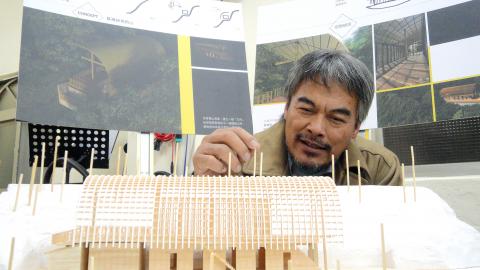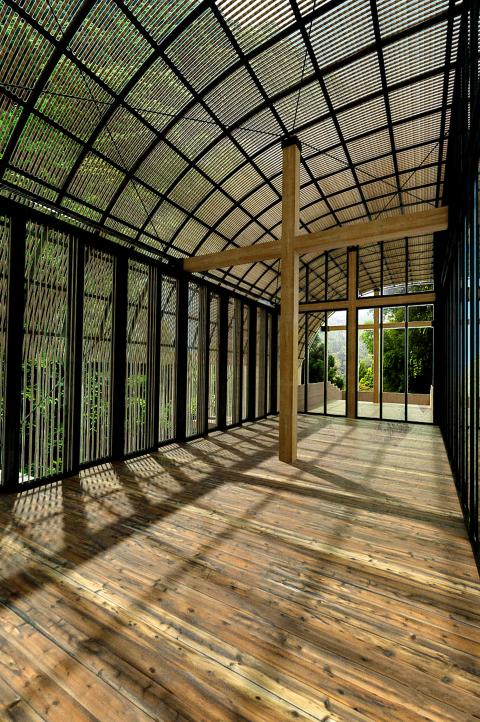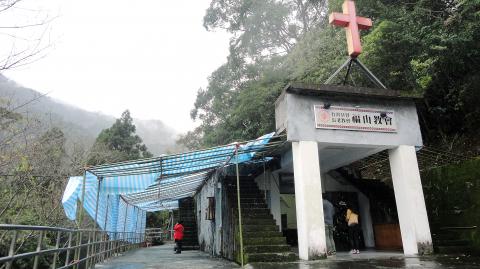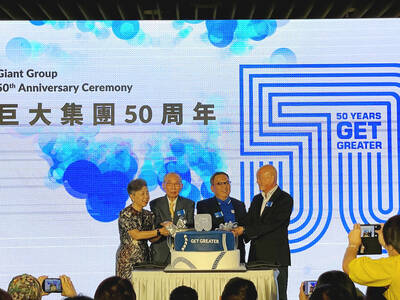Even before preacher Lin Ching-tai (林慶台) took over the ministry of Fushan Church (福山教會) in New Taipei City’s Wulai District (烏來), he knew that he faced an uphill struggle — a decreasing number of villagers and a church with huge holes in its roof.
“The state of the church shocked me,” Lin told the Taipei Times while standing in front of the two-story structure and pointing to a large piece of tarpaulin that covers the roof’s most serious leak.
“It’s too small and was leaking everywhere,” Lin, who had a role in the movie Seediq Bale (賽德克.巴萊), added.

Photo: Tang Hsiang-yi, Taipei Times
The idea to repair the church then emerged. But Lin wanted to do more than just fix the roof. The preacher said that by restoring and expanding the church, he hopes to create a positive educational space for Atayal children, who have to study elsewhere after elementary school because there isn’t a junior high school in the village.
“They only come back for summer and winter breaks, until they finish high school or college … After six to ten years of separation, they’ve lost touch with their Atayal roots,” Lin said.
Lin said it is a problem that is compounded by the fact that many returning teenagers have dropped out of school and have developed bad habits such as smoking, drinking and drugs. A new lease on the church’s life, he hopes, would translate into a more positive environment for children who seemingly have little hope.

Photo courtesy of Wooyo
But Lin’s plan requires money, manpower and architectural expertise, none of which he had ready access to. So he turned to the Taiwan Fund for Children and Families’ (家扶基金會), which connected him to FlyingV, a company that specializes in crowd funding.
CROWD FUNDING
A relatively new way to raise money in Taiwan, crowd funding gathers donations from individuals who support endeavors initiated by other people, usually via the Internet. Recent start ups include Opusgogo, Zeczec (嘖嘖) and Limitestyle.

Photo: Tang Hsiang-yi, Taipei Times
FlyingV began operations in March of 2012 and has since become Taiwan’s most successful crowd funding platform by dollars raised, project numbers and membership. It brought in NT$8.6 million for 27 projects in its first year, and more than NT$41 million for 110 projects last year.
Lin Ta-han (林大涵), FlyingV’s product director, cites Attack on Flour (太白粉的進擊) as a successful example. A parody of the Color Run, in which runners are showered with colored powder, Attack on Flour showered runners with corn starch.
“If the power of crowd funding could make this event happen, perhaps it can also build a church, and perhaps a hospital or a school,” Lin Ta-han said.

Photo courtesy of Wooyo
According to its Web site, FlyingV charges an 8 percent administrative fee. If the project doesn’t reach its monetary target, no fees will be charged, and all donations are returned to supporters. All projects have a set period of time, and supporters can donate until the time is up, even after the project has reached its fiscal goal.
“As long as the project has a clear goal, a target audience and some attractive qualities, it is a good fit for crowd funding,” Lin Ta-han said.
THE ARK PROJECT

Photo courtesy of Wooyo
Launched online last October with a goal of raising NT$7.7 million by April 30, the project has already received NT$700,000 in donations as of Saturday.
Hom Liou (劉冠宏), founder of Wooyo (無有), an architecture firm, leads the restoration effort. He says he plans to double the church’s current space with an arch-shaped roof supported by wooden crosses, which will bring in natural ventilation and light to minimize electricity bills.
Liou said the idea for the arched roof is taken from an Atayal myth, which tells of a “rainbow bridge” that leads to the spirits of their ancestors.
Computer simulations of the church show a structure resembling an ark, hence the project’s name: The Ark Project (方舟計畫), an obvious reference to the Biblical story of Noah’s Ark.
“In the Bible, Noah built an ark to save lives. My church seeks to do the same,” Lin Ching-tai said.
For more information, visit the Ark Project’s main page at www.flyingv.cc/project/1612.

In recent weeks the Trump Administration has been demanding that Taiwan transfer half of its chip manufacturing to the US. In an interview with NewsNation, US Secretary of Commerce Howard Lutnick said that the US would need 50 percent of domestic chip production to protect Taiwan. He stated, discussing Taiwan’s chip production: “My argument to them was, well, if you have 95 percent, how am I gonna get it to protect you? You’re going to put it on a plane? You’re going to put it on a boat?” The stench of the Trump Administration’s mafia-style notions of “protection” was strong

Oct. 6 to Oct. 12 The lavish 1935 Taiwan Expo drew dignitaries from across the globe, but one of them wasn’t a foreigner — he was a Taiwanese making a triumphant homecoming. After decades in China, Hsieh Chieh-shih (謝介石) rose to prominence in 1932 as the foreign minister for the newly-formed Japanese puppet state of Manchukuo in today’s Northeast China. As ambassador to Japan, he was to represent the last Qing emperor Puyi (溥儀) at the event’s Manchuria Pavillion, and Taiwan’s governor-general welcomed him with the honors of a state guest. Hsieh also had personal matters to attend to — most

Late last month US authorities used allegations of forced labor at bicycle manufacturer Giant Group (巨大集團) to block imports from the firm. CNN reported: “Giant, the world’s largest bike manufacturer, on Thursday warned of delays to shipments to the United States after American customs officials announced a surprise ban on imports over unspecified forced labor accusations.” The order to stop shipments, from the US Customs and Border Protection (CBP), came as a surprise to Giant, company officials said. Giant spokesman Ken Li (李書耕) said that the CPB never visited the company’s factories to conduct on-site investigations, nor to interview or

The Korea Times announced the results of K-universities Global Excellence Rankings 2026, the nation’s first comprehensive assessment of global performance across its universities. The evaluation was launched to provide an objective analysis of the globalization status of Korean universities and to offer practical guidance for international students choosing institutions in South Korea. KOREA UNIVERSITY RANKS FIRST In the overall rankings, Korea University secured first place with a total score of 144.86, followed by Seoul National University (141.48) and Yonsei University (140.33). Rounding out the Top 10 were Sungkyunkwan University (132.20), Hanyang University (124.83), Sogang University (112.27), University of Seoul (111.10), Ewha Womans